QuestionI have a 10 gallon freshwater tank. It had been my sister's and was a bit neglected.
She had a few tetras and one of those tank cleaning fish, a good size one.
Well, when I took over the tank, i made the mistake of going to "superstore" and purchased some more tetras.
The fish count was at 10.
The next day the fish started dying off, one by one in a mater of about three days they were all dead, including the tank cleaner one and two of her origonal ones. There was only one fish left.
So, I purchased some 5in1 test strips and found that the nitrate level was extremely high.
I purchased a product called PhosX, which is suppose to get rid of nitrate, nitrate and amonia.
Mind you, the amonia levels were fine, the ph a little low.
I have done SEVERAL water changes over the l ast few weeks to get the nitrate down. I have cleaned the gravel, cleaned the filter, replaced the cartridge and even use spring water when changing the water.
The nitrate has finally come down to the point wehre it is slightly higher then 40 on the 5in1 strip, but definately lower then the next level of 80.
My question is, how can i get RID of the nitrate all together?
I did go and purchase some harlequin fish so that the one would not be alone and so far the five of them are surviving fine even though there is a bit of nitrate.
How can i lower or get rid of it? Do I need to just simply wait for the biological filteration to build back up?
Second question: I would like to purchase a large tank in the future, about 100 gallons. I have heard that using water stright out of the tap can give fish ick and can cause other problems.
So, how do you do water changes without having to store 100 gallons of water jugs? I know about those python water changers, but is that an okay way to do it and how do you add conditioner to the water before it hits the tank?
I just dont know how to do water changes for large tanks.
thanks you for your time and help.
Nancy Williams
AnswerDear Nancy,
Yes I believe your initial problems were indeed too high nitrates and probably even low pH due to neglecting tank maintenance. (Gradually your pH drops in an aquarium that gets very little or no water changes because decaying organic matter break down in the water and produce acid--therefor lowering the pH of your water) The extra tetras you tried to add were probably in shock due to the high nitrates and totally different water chemistry from what they were accostumed to in the petstore.
Not that low pH is all that bad. But it's a million times better and healtheir for your fish to keep your pH stable simply by doing frequent water changes.
I'm sorry to say this but you could indeed have a problem on your hands now from cleaning the gravel, filter, and replacing the cartridge. This is because there are special beneficial bacterial colonies whom convert dangerous ammonia from fish wastes into harmless compounds. These bacterial colonies are essential and are vital to establishing in every aquarium. Without them keeping an aquarium healthy wouldn't be possible. Now bacterial take many weeks to colonize and develop on your gravel bed and filter, but if you do an overcleaning, the bacterial colony could certainly be wiped out as they are sensitive to chemicals, chlorine in tap water, and drying out of course and many other things. So without bacterial colonies present, your ammonia and nitrite levels may not be at ZERO where they must be at all times for your fish to survive. Any trace of ammonia or nitrite can cause severe stress on any fish or aquatic life. Ammonia and nitrite should always be consistantly zero.
I've never used PhosX but be sure it does not give false readings on your ammonia, nitrite, and nitrate levels. Some products like that do.
~*The best solution to high levels of nitrate or sudden spikes in ammonia or nitrite is 30-50% water changes. Only use a gravel siphon and bucket when doing water changes. Remember to always make the replacement water equal in temperature to that of your aquarium and insure it is properly dechlorinated with a good water conditioner too.~*
So where do you go from here?
1.) Insure your ammonia and nitrite levels are where they should be----Always-0 ~ if these levels are in trace amounts or higher a 30-50% water should be done without delay....
2.) Remember to only use an aquarium gravel siphon and bucket when doing water changes.
3.) Just leave things as they, don't disturb the gravel bed or the filter too much that might harm the bacteria.
4.) Water changes are the BEST solution to any water quality problem.
5.) Healthy aquariums have a nitrate reading of 20 or less. Less is better of course. But remember it is normal and Ok to have a little nitrate.
Large aquariums are wonderful! A 100gallon aquarium is no where comparable to a little 10gal. Especially when water changes must be done. A lightly stocked 100gal aquarium may only need a 20% water change once a week. Which is not too terrible, since that would only be about 20gals to fill back up. But if you plan on larger or fish with a higher bioload, perhaps even a 30% or larger water may need to be done twice a week. It just depends on your individual aquarium and the fish you keep in it.
I know the python water changer is a very easy way to do a water change with no lifting or carrying water. But i've never used it and have always done water changes the old fashioned way--draining the aquarium by using a regular aquarium siphon attatched to a extra long hose that can either run into a 55gal sturdy trash can (for later garden use) or directly out a door and onto the garden or grass.
This is the best way I have found since you do not waste water but allows you to water the garden or grass with aquarium water that plants love. I then always fill all my aquariums by having two 1gal pitchers reserved for aquarium use only. I add 1/4 teaspoon of water conditioner for each gallon, I set it in the sink and run tap water..Adjusting it and checking with a aquarium thermometer and adjusting the "hot" and "cold" accordingly. Once I have the temperature established and correct, and that one pitcher is filled, I take the other 1gal pitcher, add water conditioner (leaving the tap running at the same adjustment) and now set it to fill with water. I take the first pitcher and carry it to the tank, by the time I get back to the second pitcher, it is usually filled up. Then I repeat this over and over and it really saves time to be pouring water while another pitcher is filling. I have done this technique on all my aquariums including ones up to 105 gallons. It can be done, it's not as bad as you think it will be.
I really hope this helps Nancy, and I wish you only the very best!
Happy fishkeeping--best of luck!
Karen~

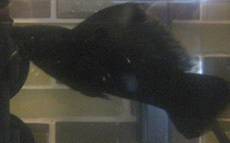 Setting up a brackish tank
QuestionSailfin Molly?
QUESTION: Hi Renee,
You
Setting up a brackish tank
QuestionSailfin Molly?
QUESTION: Hi Renee,
You
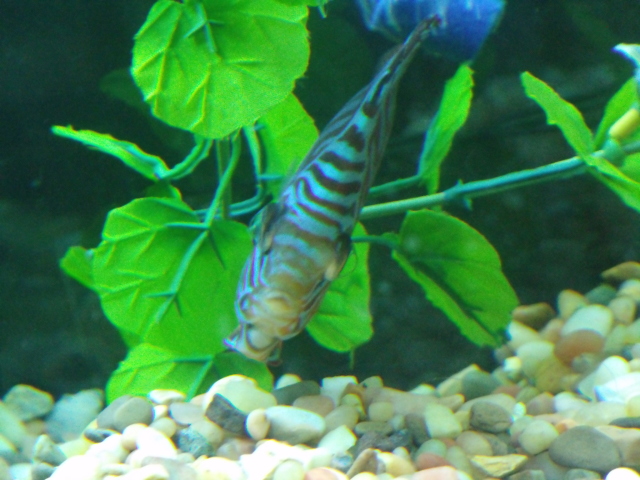 Discus with popeye not eating
Questionpopeye, possible hole
QUESTION: I was d
Discus with popeye not eating
Questionpopeye, possible hole
QUESTION: I was d
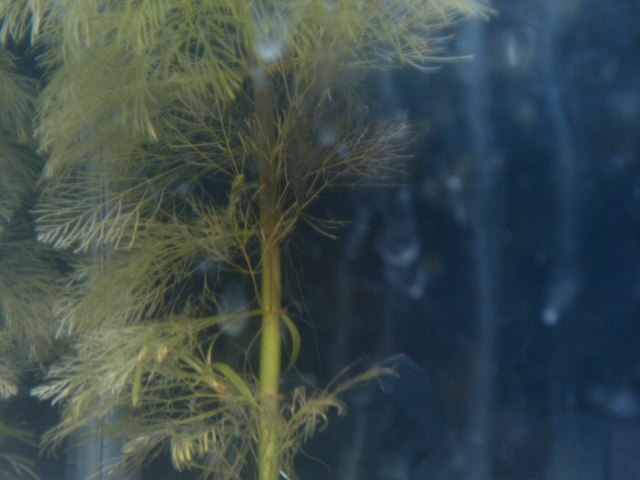 Aquatic plants dying
Question
Stem of the dying plan
Hi Matt,
Suddenly plant
Aquatic plants dying
Question
Stem of the dying plan
Hi Matt,
Suddenly plant
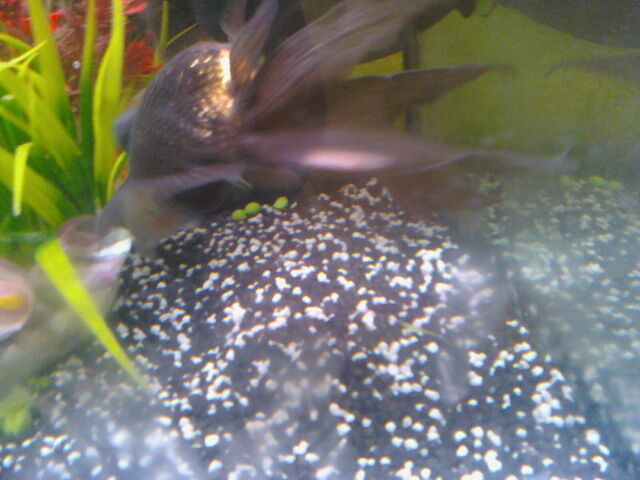 RE: Sick blackmoor
Question
Blackie
Hi,
I just want some advice on a blac
RE: Sick blackmoor
Question
Blackie
Hi,
I just want some advice on a blac
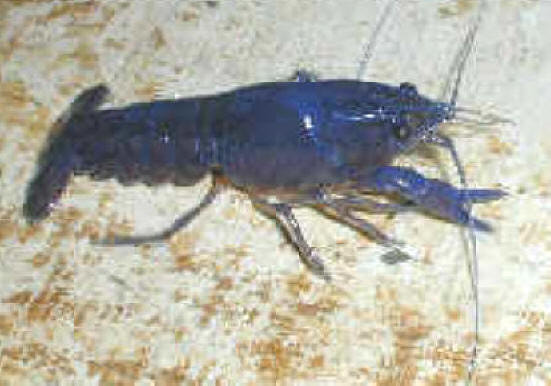 Blue lobster
Questionblue lobster
QUESTION: Hi Richard,
Can a
Blue lobster
Questionblue lobster
QUESTION: Hi Richard,
Can a